“Mirlitones”, a Fragile and Complex Sonorous System
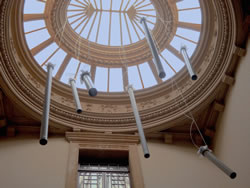
During the past twenty years we have focused in particular on the development of autonomous installations. We like to call our creations “music machines”: music to emphasize our interest in the quality and organisation of sound and machines to suggest the presence of mechanical elements and productivity. No trickery is involved. It is just the machines playing largely their own game in a fascinating world somewhere between order and chaos. The movements and sounds created by these machines can change almost imperceptibly from order into chaos and vice versa. In a certain way, the machines themselves possess a creative potential. The role of the computer in our installations is paradoxical: although it controls the mechanics (often electric motors), it can only partly foresee the physical outcome of its decisions (Bosch and Simons 2005).
As with most of our projects, complex and unpredictable processes play an important role in Mirlitones (2012–13), but when first encountered, sound and image may seem austere (Fig. 1). While most of our works produce sound within a large dynamic range, provoked by a vibrant behaviour, Mirlitones is definitely one of our most static pieces. Unlike for most of our works, hardly anything visual happens. Its sound is dominated by simultaneously sounding drones, like in our very first installations, Bamboo-Air (1987) and Was der Wind zum Klingen bringt (1989–90). Drones require a very different approach in terms of programming or writing a score. In music, a drone is usually understood as, and is presented as a monotonous low tone, but this does not exclude subtle changes in volume and timbre. Also, interferences that may occur between simultaneously sounding frequencies, like beats and difference tones, are phenomena that may be used as tools to create a musical language with exceptional qualities.
Bamboo-Air (1987)
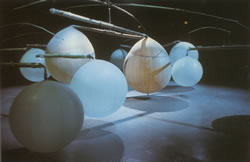
Bamboo-Air was one of the three installations that formed part of Bamboo, a project that we realized in collaboration with Hans van Koolwijk and performed at Amsterdam’s Aorta in 1986. Bamboo-Air is a huge mobile (nine meters wide) that has ten bamboo bass flutes varying in size between 1 and 3.20 m that float in space and are powered by their own air reservoirs. Large balloons are attached to the flutes and supply the air for each flute individually (Fig. 2). In 1987 we developed the piece further, adding small electret microphones to the flutes of this hitherto unamplified sound installation. Before a performance the balloons are filled with air and the mobile is wound up and then tied up to prevent preliminary movement. At the beginning of a performance we open the flutes and release the mobile, which then starts to turn around slowly.
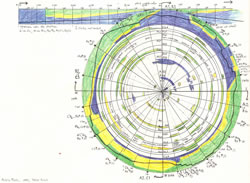
In the course of 1987 we wrote four scores for the work. “Mobile Music” (Fig. 3) is definitely the most exciting one, for its outcome has a direct relationship with the mobile’s behaviour. It is a fader score for sound and light: colours are mapped to frequencies of the flutes, and the positions of sound and light faders are related to the movement of the mobile. Each time one of the four arms of the mobile passes a certain point in the space, the sound and light technicians start following the instructions in the corresponding quarter of the circle in the score. Because the rotational movement of the mobile diminishes gradually, more and more sections of the score are performed until the mobile comes to rest (after about 28 minutes). From then on, the technicians improvise until all balloons are empty and all flutes are silent. A 4-channel sound rotator was used to intensify the relationship between the “real” and amplified sounds, resulting in a unique synesthetic experience. 1[1. This particular score was performed at the ISCM World Music Days at Stadtgarten in Cologne in 1987 and at the 7th festival Printemps électroacoustique at Montréal’s Musée d’art contemporain in 1992.]
Was der Wind zum Klingen bringt (1989–90)
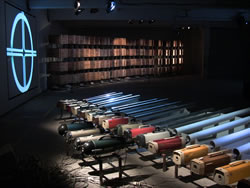
After Bamboo-Air, Was der Wind zum Klingen bringt was our second installation in which air pressure is transformed into sound. 2[2. You might have experienced its extreme loud sonic world at the Kelvingrove Gallery in Glasgow during the ICMC 1990 or at the ZKM in Karlsruhe during the 1991 MultiMediale2.] The extremely powerful sonic output of this piece required a somewhat different compositional approach than for Bamboo-Air. Here, simultaneously sounding drones are also used, but most of the time only a small number of them play together. At first sight, the project appears to be no more than a rather extraordinary organ (Fig. 4) — but there is a lot more to it than that. The way the vacuum cleaners force the air through the attached rubber tubes and the resulting turbulence has scientific significance. Each tube is an independent, small but more or less chaotic system and, as a consequence, the sound produced is extremely lively. Forty-eight vacuum cleaners arranged in four different groups provide air. This air is blown through vibrating rubber appendages into PVC and metal pipes that act as amplifying sound chambers. The arrangement is controlled by a computer switching the vacuums on and off according to a score displayed on a monitor (Fig. 5).

This self-generating score is based on the principle of cellular automata, developed in the early 1950s by John von Neumann and Stan Ulam in the United States (von Neumann and Burks 1966). Each vacuum cleaner can be either “dead” or “alive” (black or white in the score, respectively). The computer may choose the same procedure for all vacuums or apply different rules for different groups of pipes at the same time. An apparently unpredictable sequence of timbres, harmonies and dynamics are combined to create the illusion of a living object.
Mirlitones (2012–13)
Created more than twenty years later, Mirlitones resembles both early Bosch & Simons works in various ways. 3[3. Mirlitones was commissioned by DordtYart in Dordrecht, Holland, and shown in their space during the Kunst Werkt exhibition from April-September 2012.] While its musical language is similar to the one of Bamboo-Air, its coarse, “fat” sounds at a rather high volume remind us more of Was der Wind zum Klingen bringt. The most remarkable difference is maybe its appearance: the absence of an impressive, voluminous image or any visual distraction gives way to the power of sound as a spiritual medium. The public is invited to sit on deck chairs, spread out on a yoga mat, or move around in the space, discovering beats and other interferences that may emerge and disappear between simultaneously sounding frequencies (Fig. 6).
The title of the work refers to a primitive instrument that has appeared in a multitude of forms worldwide. All these instruments contain a hollow form with a membrane mounted that can be brought into vibration by blowing or singing. The best-known member of the family is the kazoo, used until present times in popular music. The point of departure for the work was the spectacular noise produced by children with minuscule plastic mirlitons in the cavalcade of the Funeral of the Sardine, the final act of the biggest fiesta in the Spanish town Murcia.
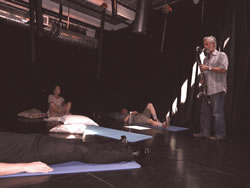
In 2004 we built giant lion’s roars for Último Esfuerzo Rural, where we created a new context for age-old instruments. Also the Mirlitones are much bigger than their predecessors and produce a constellation of sounds little known in musical practice. The installation exists of suspended vertical pipes, one to three meters long, equipped with a vibrating membrane at the upper side. The air used to bring the membranes into vibration comes from a compressor and a web of tubes and taps controlled by a computer. The length of the pipes is related to the diameter of seven planets and the elapse in time of the dynamics for each pipe is deduced from its day and night cycles. Each pipe is treated differently so that a slow, hypnotizing and ever-changing sound mix results. Small fluctuations in the air pressure cause subtle changes in the sound, composed of low frequencies, harmonics and phenomena such as beats and combination tones that arise from simultaneously sounding pipes. Because all the pipes share the air from the same limited source, each influences the others’ presence and participation. The result is a fragile and complex sonorous system, unpredictable down to the smallest detail.
A practical aspect of the work is that all its essential components can be brought into a plane as personal luggage. The pipes can easily be bought in the country where a show takes place and a compressor is a device that can be found everywhere. The first time this formula was used was at the Kidogo Art Institute in Fremantle, Australia, as part of the ICMC 2013 and the Totally Huge New Music Festival. Another novelty there was a special event: a performance by Canadian bass clarinet player Krista Martynes who improvised with the work for 15 minutes after a short introduction on the work by Peter Bosch.
During the 2015 Sound Travels Festival of Sound Art, held in Toronto in August 2015, the same formula was repeated. At the last day of the exhibition in the NAISA Space, several improvisation sessions of around eight minutes were realized by Glen Hall on bass clarinet (Audio 1), which proved to be an interesting encounter between a human and a complex music machine.
Conclusion
With Mirlitones we have returned to a musical concept that was already present in our very first projects, around twenty-five years ago. Drones and interferences between their frequencies are the protagonists of its sonic output, while silence and percussive sounds are completely absent. Over the years we have built up a reputation with music machines that are active both visually and acoustically, and many may have been surprised by our choice of giving full priority to sound this time. Nevertheless, sound has always been of great importance for all our projects, with the visual always serving the sonic output, so why wouldn’t we reduce distracting visual elements to a minimum when sound turns out to be really powerful? In the various performances of Mirlitones so far we have received many enthusiastic responses from people who said to have undergone meditative and even physical experiences while visiting the installation, due to its powerful low frequencies.
Bibliography
Bosch, Peter and Simone Simons. Stop Look Listen. [Exhibition catalogue]. Valencia: Universidad Politécnica de Valencia, 1999.
_____. “From the Vibratory Projects Until the Ultimate Rural Effort.” A Minima 8 (2004), pp. 44–60.
_____. “Our Music Machines.” Organised Sound 10/2 (August 2005), pp. 103–110.
_____. “Les Musiques du Chaos.” Thèm’Axe 10 (2011) “entre séduction, peur et chaos…” Edited by Laurence Le Diagon-Jacquin and Patrick Kersalé. Lyon: Édition Musicales Lugdivine, pp. 104–108.
_____. “The Music Machines by Bosch & Simons, 1989–2012.” Visionaries 21, Vol. 1. [DVD]. Melbourne: Contemporary Arts Media, 2013.
von Neumann, John and Arthur W. Burks. Theory of Self-Reproducing Automata. Urbana IL: University of Illinois Press, 1966.
Social top